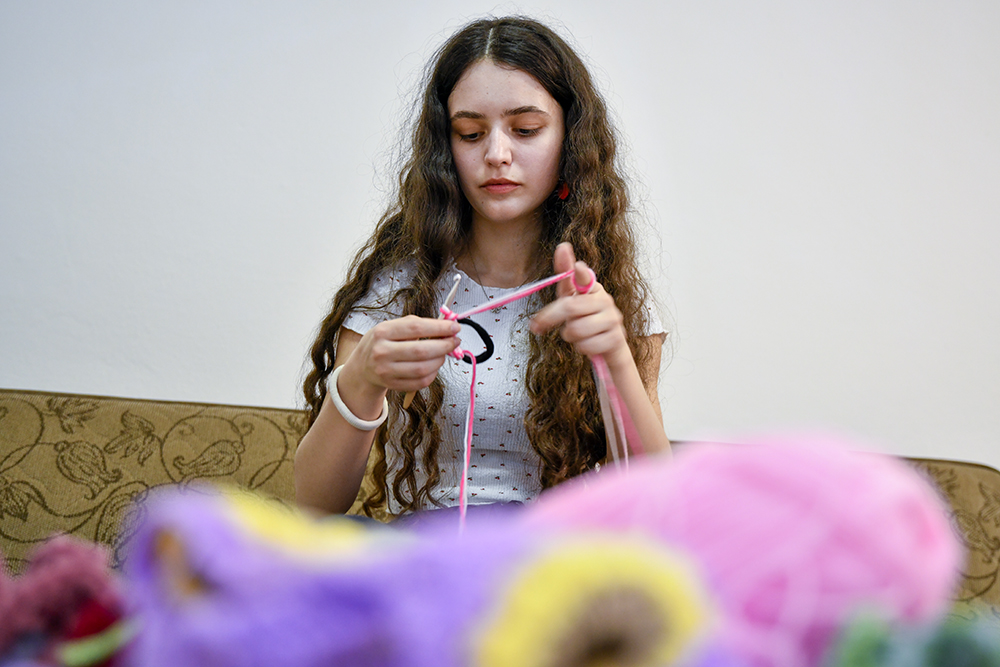It was mid-May, and the first few warm days had just set the scene for summer when Vesa Galica shipped her first-ever international order. The paper-wrapped package, adorned with a strand of cotton yarn, flew over the ocean toward Florida in the U.S. It contained a white bikini set and two mesh beach skirts — one white and the other red.
Vesa had spent a month working on the three pieces, crocheting them stitch by stitch with a hook, in her hometown, Vushtrri, in between a busy schedule of online college classes and assignments. With DHL Express, it took no more than a week or so for the package to arrive at its destination.
“The girl who made the order, the biggest one I’ve had so far, had seen my crochet designs on my Instagram page, and then messaged me there,” Vesa recounts, as she heads toward a cafe from the University of Prishtina’s Faculty of Electrical and Computer Engineering building where she has just completed one of her final college exams of the semester.
The 19-year-old computer engineering student first began to share her crochet skills two years ago, having initially learnt them from her grandmother and aunt at family gatherings. Crotchet, knitting and sewing are part of long and nuanced histories of women’s labor, closely intertwined with gender, class and race issues. Confined, most of the time, within the domestic sphere and deemed part of the chores a woman would have to do, they have also served as practices of building friendships, solidarity and resistance among women.

Vesa Galica has begun selling her handmade crocheted garments online and is considering developing her passion into a creative small business. Photo: Atdhe Mulla / K2.0.
Vesa recalls when as a child, she would curiously observe her aunt knitting everywhere, all the time — in the kitchen, during teatime, before sleep — and not understand how whole garments could take shape simply through the fast and effortless movements of her hands. Taken by the desire to learn that “mysterious” rhythmic motion, some years later, Vesa would find herself crocheting small pieces, such as wallets, hats and scarves, mostly for friends and family.
“At the beginning, I would occasionally crochet pieces for my friends, and it was them who convinced me to open my online store. Now, I get orders all the time, mainly for bikinis and crop tops,” Vesa says, adding that the crochet work enables her to cover a large part of her expenses as a student.
Given that the youth unemployment rate in Kosovo is almost 50% — the highest in the region and three times higher than in the EU — for many students, the prospects of finding a job, let alone a fulfilling one, during or after studies, are grim. For young women, the prospects are even bleaker, with the unemployment rate rising to a staggering 61%.
Even though her chosen profession, ICT, is considered to be one of the few sectors with significant prospects of increasing youth employment, Vesa is already thinking of growing her online crochet shop into a small business if she were to have trouble finding a well-paid job as a computer engineer.
“I’m looking to do a coding internship during the summer, and after graduation, next year, I intend to find a programming job,” Vesa says. “But I also have this image in mind of my crochet business as a space where other women, both older and young, could get employed, stitch together and express their creativity.”
Vesa’s plans come with a quite subversive echo.
Less than a quarter of registered businesses in Kosovo are currently owned by women, while the ICT sector is also far from equal terrain in terms of gender, despite women’s bold presence in recent years. Put into the wider socio-economic context, where just one in 18 women aged 15-24 (and one in seven women overall) are employed, and where women’s unpaid labor is estimated to be worth 2.6 billion euros, Vesa’s ambitions begin to sound almost revolutionary.
Even though promises of new jobs have been the refrain of the electoral discourse in the last decade and several strategies already address the issues surrounding structural patterns of unemployment, to date few meaningful results have been achieved.
Surplus of strategies, scarce results
The issues of women’s labor force participation and youth unemployment rates both formed key parts of Kosovo’s 2016-2021 National Development Strategy (NDS) — a central coordinating plan aimed at establishing “a new approach toward development policies” and identifying the “highest priorities of the country.”
When the drafting process of the NDS was initiated by the Office of Strategic Planning (OSP) back in 2015, the strategy was viewed as a crucial document that would serve to harmonize existing policies and small-scale strategic plans, stirring up cohesive inter-institutional coordination and avoiding the duplication of strategic projects.
Divided into four main areas — human capital, the rule of law and good governance, competitive industries, and infrastructure — the strategy ambitiously covered a wide-span of issues, from pre-school education to sustainable energy capacities and waste management. In April 2017, it was then followed by a detailed roadmap document listing all the planned activities and measurable indicators for each objective.
Now, five years after its adoption, it seems that the NDS has failed to escape the mantra heard regularly in everyday public discourse: “We have great laws, regulations and strategic documents, but we fail yet again when it comes to implementing them.”
With the implementation timeframe almost at an end, it is evident that the government will fail to meet its targets in the majority of its 15 macroeconomic indicators. Among those identified as having particularly poor performance are women’s labor force participation and youth unemployment rates.

Head of the government’s Office of Strategic Planning Vedat Sagonjeva admits that the National Development Strategy is unlikely to meet its targets and says there are lessons to be learnt for the future. Photo: Atdhe Mulla / K2.0.
Vedat Sagonjeva, the director of the OSP, has been one of the people involved in the drafting and implementation process of the strategy since the start. Sitting in his office in the government building in central Prishtina, with a large Sustainable Development Goals 2030 poster behind his back, he tries to wear the cloak of critical self-reflection when asked about the strategy’s results.
“We are still waiting for the final evaluation; however, it is clear that the level of implementation is not satisfactory,” he says. “When drafting the strategy, we focused on making sure there would be enough budget for its implementation, and that its objectives would be well-integrated within other planning documents, but the monitoring mechanisms did not prove to be effective.”
Some of the main reasons for the unsatisfactory implementation of the strategy are the same issues that the document itself was supposed to address: limited policy coordination between different institutions, lack of accountability or systematic progress evaluation, and a shortage of political will.
On top of that, the five-year implementation period has been particularly unsteady politically, with five different governments within these years.
According to a report published in April 2021 by the GAP Institute, “the unstable political environment” significantly limited the impact of the NDS 2016-2021, rendering the implementation of long-term policies almost unattainable due to rapid changes in governmental agendas.
Blend Hyseni, a GAP senior researcher who helped to compile the report, adds that the political instability made it easier for the governments to sideline the strategy as irrelevant, with each of them beating the drums for their own programs. “Previous governments could justify themselves for not achieving NDS objectives by saying that they were not particularly aligned with their plans and policies,” he says.



